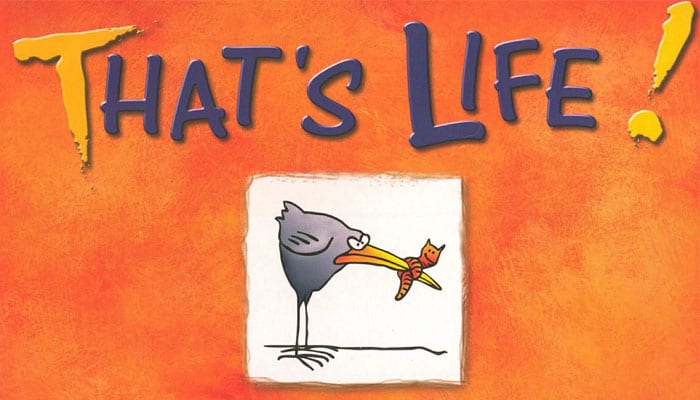
Would You Believe It!
just as you thought you were about to win the game, you have to collect the minus card - well that's life! But even the last card can change everything. After all - he who laughs last laughs loudest!

Components
- 8 route plus cards
- 18 route minus cards
- 6 route fortune cards
- 1 blue "Start" card
- 1 orange "Finish" card
- 18 figures
- 8 guards
- 1 dice
- Instructions
Object of the Game
Players use their skill - and luck - to collect as many plus (+) and fortune cards as possible, while trying to avoid the minus (-) cards.

The fortune cards are particularly important because they are used to convert any collected minus (-) cards into plus (+) cards.
The player with the most points at the end of the game is the winner.
Setup
Before playing for the first time, carefully remove the stamped components from the board.
Place the Start card. Route cards and Finish card on the table as shown here.
Put the 8 guards on the 6 fortune cards and on plus (+) cards "+8" and "+7".
Each player chooses a color and takes:
- 3 figures (2-4 players) or
- 2 figures (5-6 players) and places them on the blue Start card.
The youngest player goes first,and takes the dice.

Game Play
Take turns, moving in a clockwise direction.The player whose turn it is throws the dice. They then either move one of their figures or one of their guards.The next player continues the game.
A player may move their own figure at any time, but a guard may only be moved if there is at least one figure on that route card.This figure can belong to any player.
 The guard may be moved by any player (not only by Green). |
If there are only guards on a route card, none can be moved.
Move across as many cards as are indicated by the dice. Any number of players and/or guards may be positioned on a card. If one of the figures or a guard is moved onto the finish card, then the remaining points of the dice are not played.
 The guard may not be moved |
Taking a Route Card
When a figure is moved from a route card, and this route card is left unoccupied, the player must collect it. If the figure was not on its own. the card stays where it is.
Removing the cards creates gaps in the course; these gaps are crossed during the course of the game and are not counted when a figure is moved.
Notes:
If the gaps get too big. the cards may be moved closer together.
Once the last figure has crossed a route cord, this card can go back in the box.
Examples of moves:

It's Red's turn, and they throws a"5".They move onto the first fortune card. The minus card "-4" stays where it is because Blue is still on it.
Then Blue also throws a"5".They also move onto the first fortune card. Because no one else is on the minus card this player has to take It. Blue could also have moved one of their two other figures.

Orange throws a'*4".They can either move their figure from card "-2" to "-7" or move one of their other figures from the start card to "-5". But they don't want to do either; instead they move the guard from the first fortune card and on by four cards.
This is allowed because some of the other players' figures are on this card. Orange may not move one of the other guards because they are alone on a route card.
The Values of the Route Cards

A plus (+) c)ard scores as many points as are indicated on it.

A minus (-) card costs as many points as are indicated on it.

At the end of the game, a fortune card converts a player's highest minus (-) card into a plus (+) card.
If a player has several fortune cards, then the same number of minus (-) cards are converted into plus (+) cards.
Should a player have more fortune cards than minus cards, the other fortune cards do not score.
End of the Game
The game is over when all of the players have reached the finish card. Once a player has moved all of his figures to the finish, he stops playing.
The players now add up the values of their plus (+) cards (including those converted from minus (-) cards), then they deduct the values of any remaining minus cards.
The player with the highest number of points is the winner.

Continue Reading
